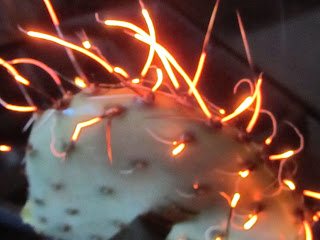Adventures in Foraging
In the end I didn't find it that useful. The Southwest is a pretty broad area and many of the plants she focuses on are native to Southern California, which has a very different climate and habitat from the high desert where I live.
I did check out the few plants from my area that were included in the book: horehound and prickly pear cactus. Regarding the horehound: it's actually growing in my garden! It's one of the plants I had been trying to identify since we moved in at the end of July. I had guessed that it was some member of the mint family judging from the stems and the leaves (turns out it's not...), but the smell and a quick taste (very, very bitter) had me stumped for a final identification. I'm happy to know what the plant is, but the identification didn't prove all that helpful. Other than making tea or candy by using lots of added sweetener, the plant doesn't seem to be that useful. Certainly, it's not the kind of plant you could eat to fill yourself up, or to get your daily allotment of vitamins and minerals.
The prickly pear, on the other hand, is a much more nutritionally useful local plant. The reddish fruits (called tunas, I believe) can be peeled and eaten by themselves or added to things like smoothies. I had a small nibble of one when we first got here and it wasn't bad at all--kind of tart and generally fruity, a little like a kiwi. Now, though, when I went out looking for some, I couldn't find any! Judging from the scat I see around here (which is filled with the seeds of the tunas), it's a favorite of the local wildlife. There are, however, plentiful pads from the plant itself. Just walk out my front door, and you could fill bag after bag of these pads.
 |
| Horehound with flowers |
I've run into the vicious thorns of these plants enough times to know that I'd have to be super careful while collecting some to prepare. I wore thick gloves and used a sharp knife to separate pads from the plants. I dropped the plants into a plastic bag to carry back to my kitchen. In retrospect, the choice of a plastic bag was stupid; the thorns just tear right through the plastic and into your legs and arms. The pads also get all caught in the plastic and are then difficult to take out of the bag. I imagine cloth or plastic bags would work much better.
 I read in Farnsworth's book and on a few other sites on the internet that in order to prepare the pads, I should hold them under running water in the sink and use a knife to scrape off the spines. That sounds much more straightforward than it proved to be. I held a pad in my hand and scraped at it for a few minutes. A few spines came out, but I noticed that my fingers were now bristling with in the neighborhood of a hundred teeny, tiny spines. These small hairlike spines, I later learned, are called brochids. The knife was not at all effective in removing them from the pad, and to get them out of my fingers I had to use my teeth since they were too small to remove with tweezers. I was still picking them out hours later and I even somehow managed to get some embedded in the fabric of my shirt. And the pad I had worked on still held most of its spines and thousands of the brochids.
I read in Farnsworth's book and on a few other sites on the internet that in order to prepare the pads, I should hold them under running water in the sink and use a knife to scrape off the spines. That sounds much more straightforward than it proved to be. I held a pad in my hand and scraped at it for a few minutes. A few spines came out, but I noticed that my fingers were now bristling with in the neighborhood of a hundred teeny, tiny spines. These small hairlike spines, I later learned, are called brochids. The knife was not at all effective in removing them from the pad, and to get them out of my fingers I had to use my teeth since they were too small to remove with tweezers. I was still picking them out hours later and I even somehow managed to get some embedded in the fabric of my shirt. And the pad I had worked on still held most of its spines and thousands of the brochids.
I was reluctant to try again using this method, so I decided to go with plan two: Singe off the spines and brochids over an open flame. I impaled a pad with a knife and held it over the flame of the gas stove. This created a beautiful sight when the spines caught on fire. They quickly burned down and I was left with a pad covered with bright orange glowing spines. This didn't last long, just a few seconds, and then the pad seemed to be cleaned of its spines. I took it over to the sink and held it under the running water to remove the remnants of the burned spines. Silly me--I held the pad in my bare fingers to do this. The flame had not been effective in removing the brochids and once again my fingers were covered with the tiny spines. I bit most of them out (lovely image, isn't it?) and not to be deterred, tried once more with another pad, determined that this time I would burn off not only the spines but the brochids as well.
Unfortunately, I wasn't able to do this. Even though I held the next few pads under the flame long enough to partially cook them (not something I really wanted to do at this stage), after I had rinsed them under the water, there were still a considerable number of brochids stuck in the pads. Certainly there were too many in the pads for me to even consider eating them.
Now, I know that the prickly pear pads I see in the grocery store are completely devoid of spines and brochids both. But I'm left with a mystery: how do they remove them so thoroughly? Until I find out, I'm left with the image of myself, as a hunter gatherer, trying to forage for them as food, singing off their spines and brochids over a campfire, with my fingers filled with thousands of tiny bristles, starving in the midst of plenty. Not a happy thought.




Comments
Post a Comment